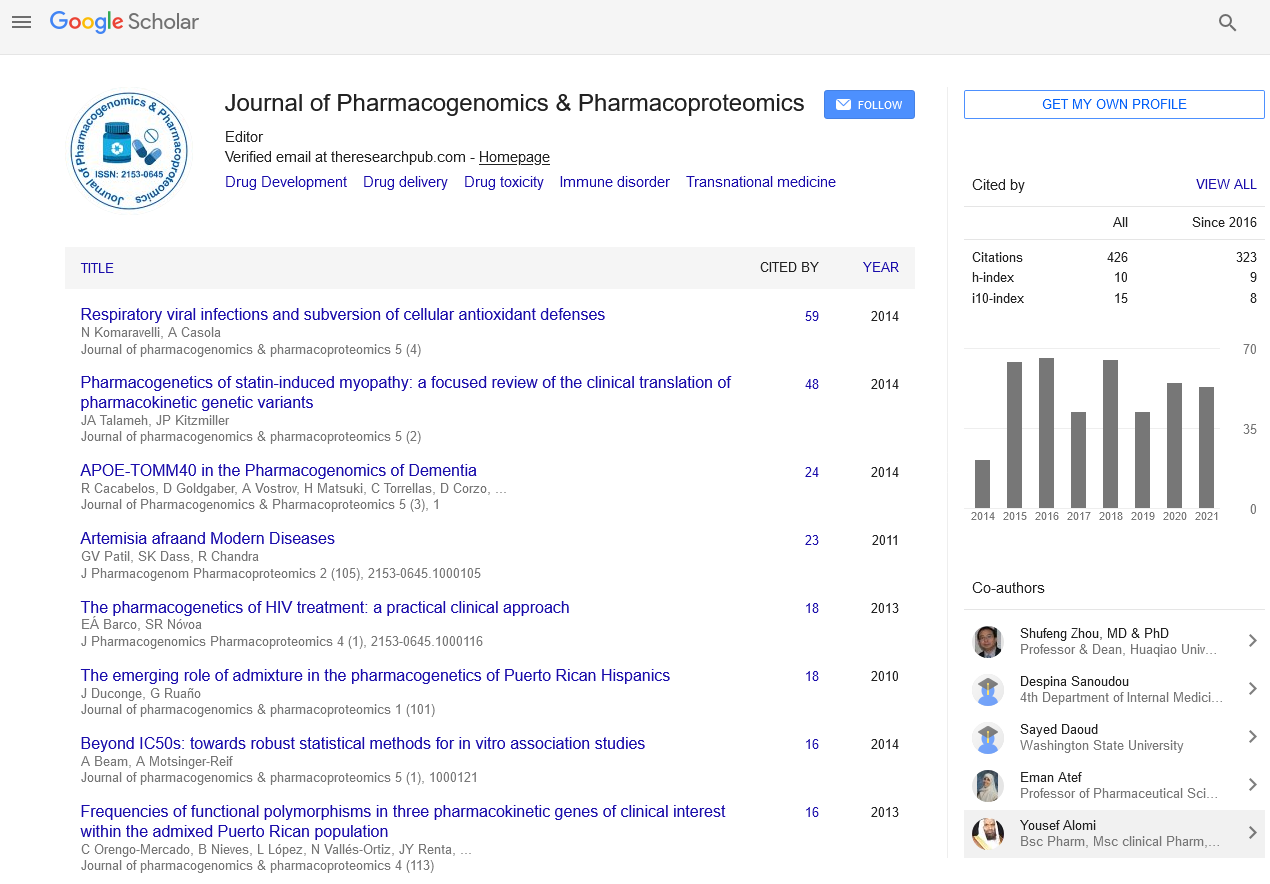Indexed In
- Open J Gate
- Genamics JournalSeek
- Academic Keys
- JournalTOCs
- ResearchBible
- Electronic Journals Library
- RefSeek
- Hamdard University
- EBSCO A-Z
- OCLC- WorldCat
- Proquest Summons
- SWB online catalog
- Virtual Library of Biology (vifabio)
- Publons
- MIAR
- Euro Pub
- Google Scholar
Useful Links
Share This Page
Journal Flyer

Open Access Journals
- Agri and Aquaculture
- Biochemistry
- Bioinformatics & Systems Biology
- Business & Management
- Chemistry
- Clinical Sciences
- Engineering
- Food & Nutrition
- General Science
- Genetics & Molecular Biology
- Immunology & Microbiology
- Medical Sciences
- Neuroscience & Psychology
- Nursing & Health Care
- Pharmaceutical Sciences
Pharmacogenetics of cerebrovascular and cardiovascular risk factors in dementia
4th International conference on Predictive, Preventive and Personalized Medicine & Molecular Diagnostics
September 22-23, 2016 Phoenix, USA
Ramon Cacabelos
EuroEspes Biomedical Research Center, Spain
Keynote: J Pharmacogenomics Pharmacoproteomics
Abstract:
Alzheimer�??s disease (AD) is a heterogeneous disorder with at least a tetravalent phenotype (neuropathological, neurobehavioral, age-related and gender-related components). Consequently, therapeutic intervention in dementia is polymodal, in order to modify the expression of all these complex phenotypes. AD patients present concomitant disorders including hypertension (20-30%), obesity (>20%), diabetes (24%), dyslipidemia (>40%) and metabolic disorders (>15%). Cardiovascular disorders (>40%), atherosclerosis (>60%) and different modalities of cerebrovascular damage (>60%) are frequent among patients with AD. Most of these concomitant anomalies may contribute to accelerate the dementia process. Pharmacogenetic studies in hypercholesterolemic patients with dementia treated with Atorvastatin (ATO)+LipoEsar (LIP) indicate that the therapeutic response to the combination of a conventional statin and a novel anti-atherosclerotic bioproduct is highly influenced by pathogenic and metabolic genes: (1) Cholesterol (CHO) levels are APOE-dependent. APOE-4/4 carriers exhibit the highest CHO levels. APOE-2/3, APOE-3/4 and APOE-4/4 carriers experience a gradual age-dependent decrease in CHO levels. (2) The therapeutic response of CHO to ATO+LIP is APOE-dependent. APOE-3/3 and APOE-3/4 carriers are the best responders and APOE-2/4 and APOE-4/4 carriers are the worst responders. (3) CYP2D6-EMs and IMs show a significant decrease in CHO levels in response to ATO+LIP, whereas PMs and UMs exhibit a poorer CHO lowering effect. (4) CYP2C9-EMs and IMs effectively respond to ATO+LIP, and CYP2C9-PMs do not respond. (5) CYP2C19-EMs and IMs significantly respond to ATO+LIP and PMs do not show any effect. (6) CYP3A4/5-EMs show a significant decrease in CHO levels after one month of treatment with ATO+LIP. Over 80% of CYP3A4/5-EMs responds to ATO+LIP, with an almost complete normalization of CHO levels. The effect in IMs is spectacular with over 90% of the patients experiencing a drastic reduction in CHO levels and 60% of RMs do not respond at all. Most of these effects can be explained on a pharmacogenetic basis.
Biography :
Ramon Cacabelos is a Professor and Chairman of Genomic Medicine at Camilo Jose Cela University and President of the EuroEspes Biomedical Research Center, Institute of Medical Science and Genomic Medicine, Spain. He has received his MD from Oviedo University, PhD from Santiago de Compostela University and DMSci in Psychiatry from Osaka University Medical School, Japan. After a decade at the Department of Psychiatry in Osaka, he returned to Spain and focused his research activity on the genomics and pharmacogenomics of Alzheimer’s disease, neurodegenerative disorders and neuropsychiatric pathology. He has published over 600 papers, 400 chapters and 24 books. One of his major contributions is the first World Guide for Drug Use and Pharmacogenomics (2012). He is the Editor-in-Chief and Member of the Editorial Board of several international journals, Member of over 30 scientific societies and President of the Spanish Society of Genomic Medicine and the World Association of Genomic Medicine.
Email: rcacabelos@euroespes.com


